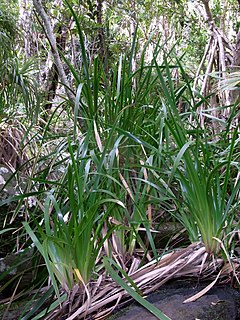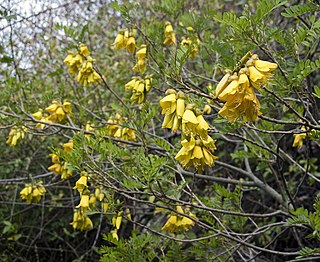Lepidium howei-insulae , commonly known as mustard & cress, is a flowering plant in the mustard and cabbage family. The specific epithet alludes to Lord Howe Island, where it is found.

Machaerina insularis is a flowering plant in the sedge family. The specific epithet is the Latin insularis, alluding to its island home.

Sophora howinsula, commonly known as lignum vitae or Lord Howe kowhai, is a flowering plant in the legume family. The specific epithet refers to the island to which the species is endemic.

Cryptocarya gregsonii, commonly known as native blackbutt, black plum or laurel, is a flowering plant in the laurel family. The specific epithet honours Jesse Gregson of Newcastle, New South Wales, a botanical friend of Maiden.
Geniostoma huttonii is a flowering plant in the Loganiaceae family. The specific epithet honours Ian Hutton who discovered the species in the course of his explorations of the Island.
Geniostoma petiolosum, commonly known as boar tree, is a flowering plant in the Loganiaceae family. The specific epithet refers to the relatively long and narrow petioles.
Rapanea mccomishii is a flowering plant in the family Primulaceae. The specific epithet honours James Doran McComish (1881–1948), who made several visits to, and collected extensively on, Lord Howe Island in the 1930s.
Chionanthus quadristamineus, commonly known as the blue plum, is a flowering plant in the olive family. The specific epithet refers to the four stamens in the flowers.

Pandanus forsteri , commonly known as forky-tree or forkedy-tree, is a flowering plant in the screwpine family. The specific epithet honours either Johann Forster or Georg Forster, father and son German botanists, who accompanied James Cook as naturalists on his second voyage (1772–1775).
Coprosma huttoniana is a flowering plant in the coffee family. The specific epithet honours Ian Hutton, the Lord Howe Island based naturalist who discovered the plant and recognised it as a new species.
Coprosma inopinata is a flowering plant in the coffee family. The specific epithet comes from the Latin inopinus (“unexpected”), because it was discovered unexpectedly in 1989, proving to be yet another species of Coprosma that was endemic to Lord Howe Island.
Coprosma lanceolaris is a flowering plant in the coffee family. The specific epithet comes from the Latin lancea with the suffix -aris, alluding to the shape of the leaves.

Coprosma putida, commonly known as Stinkwood, is a flowering plant in the coffee family. The specific epithet comes from the Latin puteo, alluding to the stench produced when the species is cut or bruised, including the leaves and fruit.
Psychotria carronis, commonly known as the Black Grape, is a flowering plant in the coffee family. The specific epithet honours William Carron (1823–1876) who collected plants on Lord Howe Island for the Royal Botanic Gardens, Sydney.
Symplocos candelabrum is a flowering plant in the sapphireberry family. The specific epithet may refer to the candelabrum-like display of stamens in the flower.

Olearia elliptica subsp. praetermissa is a flowering plant in the daisy family. The subspecific epithet means "overlooked", referring to the fact that this distinctive endemic subspecies was long overlooked.
Leptospermum polygalifolium subsp. howense, commonly known as tea tree or tea-tree, is a flowering plant in the myrtle family, Myrtaceae. The subspecific epithet refers to the island to which the subspecies is endemic.
Macropiper excelsum subsp. psittacorum, commonly known as pepper tree or kava, is a flowering plant in the pepper family. The subspecific epithet means “of the parrots”, inferring a liking by parrots for the fruits.
Pouteria myrsinoides subsp. reticulata, commonly known as axe-handle wood, is a flowering plant in the sapodilla family, Sapotaceae. The subspecific epithet refers to the reticulate venation on the leaves.
Boehmeria calophleba is a flowering plant in the nettle family.






